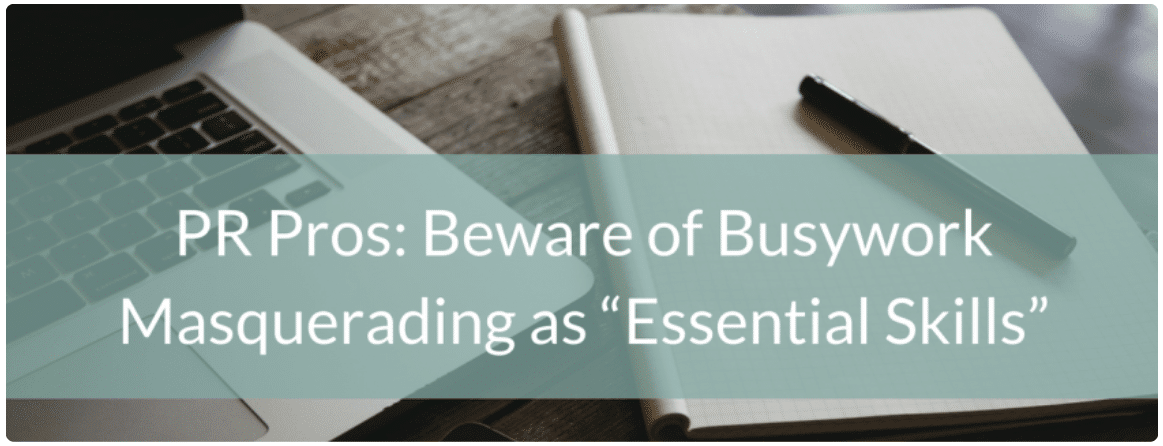Some hard truths on the PR skills we really should be developing—for our clients and our own professional development.
A well-known public relations trade site recently ran a “listicle” of so-called essential PR skills for our modern technology-driven era. Included in the list were graphic design, analytics, and even some light HTML coding.
My first reaction was moderate panic. Analytics, I totally get. But today’s PR professionals should now be expected to design collateral, tweak the coding for HTML email blasts and websites, in addition to establish a media presence, build brand awareness and help generate leads for our clients.
Well, being the people-pleasing, “I can take that on!” person so many of us in PR are, I was on the verge of heading over to Coursera when, thankfully, a second reaction kicked in: revolt.
Here’s the reality. Most of us, whether we work in an agency or in-house, already spend way too much time pecking away at keyboards on any number of non-creative tasks, much of it on the administrative end of managing public relations. Add to this an interminable stream of emails to write and respond to, and collectively, these tasks suck up more of our work week than we’d ever want to admit.
Meanwhile, on the in-house side, marketing and PR are increasingly a “catch-all” destination for other departments that want to pretty up a presentation, proofread a legal document, properly format a PDF, mail merge an email, and other “this should just take a few minutes” requests that create a lot of job creep and regularly push pressing marketing and PR projects to the back burners.
People, God HELP us if we add coding and graphic design to our never-ending “I can do that!” lists. And heaven help our clients, whether in-house or on the agency side. As we continue to get mired down in busywork, fresh ideas for PR and marketing either won’t get thought of, or will lose their potential in poorly executed campaigns.
Besides, the world is full of poorly designed marketing collateral and glitchy apps. Perhaps because we’re getting what we pay for? Let’s pay for highly skilled professionals who specialize in the high skilled work of graphic design and coding. Not pass it on to a PR or marketing professional who can do just enough to get the job done, but not very creatively.
That way, we can stay focused on continuously improving the following marketing and PR skills.
#1: More persuasively make the case for bold creativity
It’s the only kind of messaging that breaks through, yet it remains difficult to convince clients—even sometimes our own account teams—to take a risk with provocative messaging and concepts. This is something learned over time and with practice, but here are a few pointers: have examples at the ready of successful campaigns that used unusual or daring messaging; bring the client in on the creative process; and—particularly for B2b PR and marketing–don’t be afraid to challenge the conventional thinking that B2b buyers are a conservative market who just want the facts. These people respond to humor and provocative messaging just like the rest of us humans.
It also helps to foster creativity among your team or—even better—as a company value. Check out this collection of tips from an articleI once wrote about inspiring creativity in the attractions and entertainment industries–where regularly unleashing the “wow factor” is a mandate.
#2: Out-argue the lawyers
While legal expertise is needed in many companies, it is often applied to marketing and PR projects with massive overkill. Time after time I’ve seen press releases, bylines, reports, and other copy utterly diluted of any potential impact after a single legal marketing review.
I’m also convinced it was the lawyers at United who advised the CEO to refer to a bloodied, brutalized passenger being dragged off the plane as being “re-accommodated.” No self-respecting PR pro would have greenlighted this horrendous understatement. They also would have predicted that any financial settlement would be a fraction of the billions of dollars in market value lost in the wake of such a dreadful response. A hard lesson learned for United, but one PR departments everywhere can have on hand to bring up in any future debates with legal.
#3: Client relations
Investing in PR isn’t cheap, whether working with an agency or hiring an in-house team. Company leaders are often nervous about what to expect and how they will measure results. Often this is driven by anxiety over a business objective they are directly responsible for achieving. And all clients are different—with their own working and communication styles, and criteria for success. We must be able to put ourselves in many different pairs of shoes.
I can’t overstate how important regular communication with clients is to achieve this state of empathetic nirvana. It is the only way to keep a pulse on our clients’ current concerns and long term needs, both of which good PR people should always have a read on. Busywork can suck us away from these needed conversations. Don’t let it.
#4: Setting the stage for a story
I have blatantly ripped this off from a Wired article about one of the most powerful PR pros in Silicon Valley—whose chief skill is not coding or graphic design. It is, as the article noted, creating a memorable scene for a story. So think. The next time we’re pitching, what is the perfect analogy or metaphor to help explain our angle? If a meeting with a journalist will be in-person, what might be a memorable location that underscores what we want to convey?
Again, mired down in busywork takes away the needed time to conceptualize and create such settings. Which costs us dearly in unforgettable media coverage.
#5: Write better headlines
It doesn’t have to be clickbait, but the opposite end of the spectrum is just as obnoxious–those plodding, painful headlines that make use of tired corporates-peak like “ensure” and “leverage” and “enhance.” Shooting for brevity can help alleviate these tendencies, so keep press release titles to 10 words or less, email subject lines to 4 words or less.
#6: Figure out what makes buyers tick—and when
We must insist on having the time to create (or the money to hire someone to create) buyer personas and buyer journeys, to conduct customer interviews, and whatever it takes to know our clients’ target customer audiences inside and out. It is the difference in good versus scant PR results. And so here I will freely admit that yes, basic analytics is an essential skill, unless you have a department that does this for you. Many of us don’t, alas.
#7: Demand generation
We all know by now that most buyers of big ticket items have made up their minds on who they’re buying from before they reach out to a vendor. So it remains critical to get the right information to them at the right time. Demand generation, content marketing, whatever you want to call it – we do need to understand the basics, even if we hire outside firms to put together the logistics for our demand generation/content marketing programs.
#8: Measure results
PR continues to be difficult to link to sales, but there are metrics we should follow and get versed in that help us better connect the dots. Really partner with your client on this, or if you work in-house, with your marketing analytics people. One of my clients has built a special analytics dashboard that shows website traffic by customizable time frames, and where the traffic comes from. I’m able to easily correlate press release and published bylines with spikes in traffic, plus show traffic increase comparisons year over year or month-by-month.
If you don’t have all of the above skills down cold, don’t panic—neither do most of us. But getting rid of unproductive goals will make sure we have more time to become experts in these and other skills that matter most.
This article originally appeared on the Amendola Communications blog; reprinted with permission.









